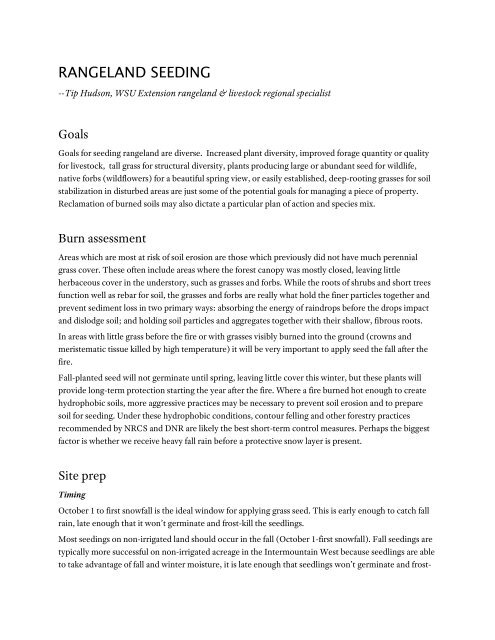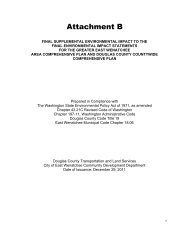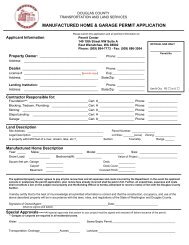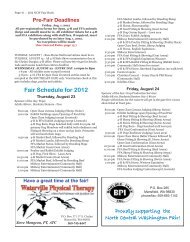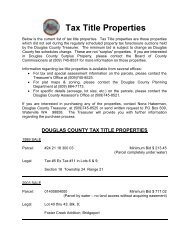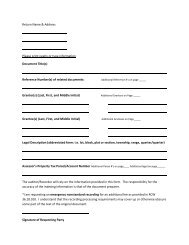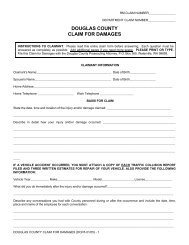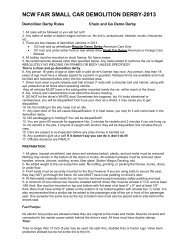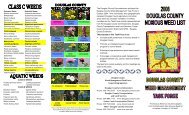Tips for Rangeland Seeding - Douglas County
Tips for Rangeland Seeding - Douglas County
Tips for Rangeland Seeding - Douglas County
Create successful ePaper yourself
Turn your PDF publications into a flip-book with our unique Google optimized e-Paper software.
RANGELAND SEEDING<br />
--Tip Hudson, WSU Extension rangeland & livestock regional specialist<br />
Goals<br />
Goals <strong>for</strong> seeding rangeland are diverse. Increased plant diversity, improved <strong>for</strong>age quantity or quality<br />
<strong>for</strong> livestock, tall grass <strong>for</strong> structural diversity, plants producing large or abundant seed <strong>for</strong> wildlife,<br />
native <strong>for</strong>bs (wildflowers) <strong>for</strong> a beautiful spring view, or easily established, deep-rooting grasses <strong>for</strong> soil<br />
stabilization in disturbed areas are just some of the potential goals <strong>for</strong> managing a piece of property.<br />
Reclamation of burned soils may also dictate a particular plan of action and species mix.<br />
Burn assessment<br />
Areas which are most at risk of soil erosion are those which previously did not have much perennial<br />
grass cover. These often include areas where the <strong>for</strong>est canopy was mostly closed, leaving little<br />
herbaceous cover in the understory, such as grasses and <strong>for</strong>bs. While the roots of shrubs and short trees<br />
function well as rebar <strong>for</strong> soil, the grasses and <strong>for</strong>bs are really what hold the finer particles together and<br />
prevent sediment loss in two primary ways: absorbing the energy of raindrops be<strong>for</strong>e the drops impact<br />
and dislodge soil; and holding soil particles and aggregates together with their shallow, fibrous roots.<br />
In areas with little grass be<strong>for</strong>e the fire or with grasses visibly burned into the ground (crowns and<br />
meristematic tissue killed by high temperature) it will be very important to apply seed the fall after the<br />
fire.<br />
Fall-planted seed will not germinate until spring, leaving little cover this winter, but these plants will<br />
provide long-term protection starting the year after the fire. Where a fire burned hot enough to create<br />
hydrophobic soils, more aggressive practices may be necessary to prevent soil erosion and to prepare<br />
soil <strong>for</strong> seeding. Under these hydrophobic conditions, contour felling and other <strong>for</strong>estry practices<br />
recommended by NRCS and DNR are likely the best short-term control measures. Perhaps the biggest<br />
factor is whether we receive heavy fall rain be<strong>for</strong>e a protective snow layer is present.<br />
Site prep<br />
Timing<br />
October 1 to first snowfall is the ideal window <strong>for</strong> applying grass seed. This is early enough to catch fall<br />
rain, late enough that it won’t germinate and frost-kill the seedlings.<br />
Most seedings on non-irrigated land should occur in the fall (October 1-first snowfall). Fall seedings are<br />
typically more successful on non-irrigated acreage in the Intermountain West because seedlings are able<br />
to take advantage of fall and winter moisture, it is late enough that seedlings won’t germinate and frost-
kill, and soils dry out relatively quickly in the spring depending on unpredictable spring precipitation,<br />
making spring seedings notoriously unsuccessful.<br />
Weed control<br />
Control weeds and other undesirable vegetation prior to seeding. Consider the timing necessary to<br />
accomplish this. Where there is a sufficient remnant population of desirable perennial plants, it may be<br />
advantageous to use selective herbicides to kill the undesirables and interseed into the existing plant<br />
community. Some herbicides that work by inhibiting germination should usually not be used in<br />
combination with a seeding. A good example is cheatgrass control. Imazapic is a germination inhibitor<br />
and it is very good at stopping or preventing cheatgrass invasion/dominance. It has little to no effect, at<br />
recommended rates, on perennial plants. It does, however, cause a problem <strong>for</strong> annual and perennial<br />
grass seed, so attempting cheatgrass control and fall seeding during the same year is a waste of seed.<br />
Soil conditions<br />
Grass seed must contact the soil to germinate. Usually harrowing or raking will expose enough soil to<br />
accomplish this. After a fire mechanical treatment may not be necessary. Once applied, the seed also<br />
needs to have ~1/8” soil coverage. A culti-packer or roller works best, but going over the field again<br />
with a harrow or drag works as well. On rangeland areas with abundant rocks or shrubs, or on sites with<br />
high slope, it may be impossible to conduct any site prep. On these areas, one is limited to a controlled<br />
burn be<strong>for</strong>e seeding, livestock impact after seeding, or take your chances with whatever litter cover is on<br />
site. Where enough slope exists to allow water runoff and soil erosion to occur, and where there is little<br />
remaining rooted vegetation to stabilize soil, it may be necessary to artificially create enough surface<br />
roughness to generate microsites <strong>for</strong> germination and physical barriers <strong>for</strong> water that may try to carry<br />
your seed away. If raking, lightly cultivating, or harrowing, travel with the contour of the slope as much<br />
as possible to minimize the potential <strong>for</strong> soil erosion.<br />
Seed application methods<br />
There are two methods <strong>for</strong> seeding: broadcast and direct/drilled. Broadcast seeding is easier on rough<br />
terrain where there are rocks, slopes, uneven ground, other vegetation, but has a lower success rate than<br />
drilled seed. If broadcast seeding, consider dragging something like a harrow over the site to scarify the<br />
soil surface and provide opportunity <strong>for</strong> seeds to contact mineral soil. Grain drills generally do not work<br />
except in deeper, rock-free soils, but a rangeland drill is designed to work around these obstacles and<br />
dramatically increases the success rate (germination and establishment of seeds).<br />
Regardless of site preparation measures, the site conditions ideal <strong>for</strong> perennial seeds are as follows:<br />
1. Seeds must contact bare mineral soil. If they are sitting on top of dead plant material seeds will<br />
either dry out or be consumed by birds and rodents. This can be usually be accomplished by a<br />
field entry with a harrow or pasture drag. If this is a pasture that has been plowed, disked, and<br />
rolled, the soil should be firm; fluffed soil from excessive tillage won’t provide enough stability<br />
<strong>for</strong> the roots and is susceptible to wind and water erosion. Tillage is not recommended <strong>for</strong> low
ainfall sites. <strong>Seeding</strong> into unplowed but harrowed or raked soil is preferable to avoid soil<br />
erosion and mass germination of weed seeds that are already in the soil seed bank.<br />
2. If tillage is used to prepare the seedbed, Topsoil (first ½-1”) should be well-pulverized and<br />
mollified. This means loose, not cloddy, but not so powdery loose that crusting takes place.<br />
Crusting will prevent seedling emergence. TILLAGE (PLOWING/DISKING) IS NOT<br />
USUALLY RECOMMENDED FOR DRYLAND SEEDING.<br />
3. The seed site should be free of invasive plants. The presence of annual weeds or perennials that<br />
are competing <strong>for</strong> the same resources as the seedling is the most common and significant<br />
obstacle to establishment. This doesn’t mean eliminating all live vegetation on the entire<br />
seeding area, as dryland areas typically have spaces between plants, but reseeding is usually<br />
done where all or part of the existing vegetation is unwanted and some level and <strong>for</strong>m of<br />
vegetation control is beneficial. This is most effectively accomplished using selective herbicides<br />
or controlled grazing on annual grasses.<br />
4. The area should be free of the seed of competitive species. This typically means ensuring that<br />
the existing undesirable vegetation doesn’t produce seed in the growing season prior to<br />
planting. If this is a concern, it may be beneficial to summer fallow the site: kill the undesirable<br />
vegetation in the fall and/or spring and give the site one full growing season to see what comes<br />
up. If you don’t want it, kill it, and plant the following fall with a better chance of success.<br />
5. There should be a moderate amount of mulch or plant residue on or in the soil surface. (Don’t<br />
scrape a site clean with a tractor!) With a fall planting, there is generally a sufficient amount of<br />
dead plant material from this year’s growing season that is incorporated through the winter.<br />
(Adapted from Kingery, 1997)<br />
Aftercare <strong>for</strong> new plants<br />
If seeding is <strong>for</strong> pasture <strong>for</strong>age, do not graze until the following year, and then only if plants cannot be<br />
pulled by hand. If you can pull the grass plants out, roots and all, they are not ready <strong>for</strong> grazing. Weed<br />
control may still be necessary, especially in year 1 and 2 post-seeding. Any kind of soil disturbance often<br />
stimulates weed seeds which are already in the soil seed bank to germinate and establish. It is not<br />
uncommon to have a profusion of weeds you didn’t even know were there to show up following a light<br />
mechanical treatment. Herbicide recommendations are dependent entirely on the weed species present.<br />
Seed selection<br />
Select seed that is well-suited to your site and your goals. A seed guide from any of the major seed<br />
dealers is a good place to start. A seed mix is preferable to a single species because each species has<br />
different strengths and weaknesses and a combination of species has much greater biological resiliency<br />
to grazing, fire, insects, drought, prolonged cold, excess moisture, etc., than a monoculture.
Dryland grass species descriptions (not <strong>for</strong> irrigated pasture)<br />
• Bluebunch wheatgrass ($) – an excellent native species<br />
adapted to low rainfall areas that is highly palatable; seed is<br />
more expensive than introduced species; exercise care in<br />
grazing to avoid late spring damage<br />
• Basin wildrye – Very large native plant that once occupied<br />
much of the Yakima floodplain; highly salt-tolerant and has<br />
an excellent root system; good <strong>for</strong> wildlife cover as well as<br />
livestock<br />
• **Crested wheatgrass (Hycrest or Nordan)– easy to establish,<br />
short-lived if not grazed<br />
• **Hard fescue – used in roadcuts to stabilize soil; easy to<br />
establish and tremendous root system.<br />
• **Intermediate wheatgrass – a good introduced grass <strong>for</strong><br />
alkaline soils; relatively unpalatable<br />
Figure 2. Bluebunch wheatgrass plant. Photo by Tip<br />
Hudson<br />
• **Siberian wheatgrass (Vavilov) – introduced, short bunchgrass that does well above 7” rainfall<br />
zones<br />
• Slender wheatgrass – relatively unpalatable but produces a vigorous root system; good <strong>for</strong><br />
reclamation<br />
• Thickspike wheatgrass ($) – a very tough grass that is good <strong>for</strong> shallow, rocky soils; tolerates grazing<br />
well; more palatable than crested wheatgrass<br />
**Good choice <strong>for</strong> value and ease of establishment<br />
$ Expensive seed<br />
Recommended seed mixes<br />
If you were to order a custom mix <strong>for</strong> post-fire rehabiliation, NRCS, WSU, and the WSU Plant Materials<br />
Center folks would recommend:<br />
Blue Wildrye<br />
6 lbs/ac<br />
Mountain Brome 4 lbs<br />
Slender wheatgrass 4 lbs<br />
Bluebunch wheatgrass 4 lbs<br />
Landmark Seed has this available (http://www.landmarkturfandnativeseed.com/, 509-835-4967); talk<br />
to Harold Wood.<br />
If you have areas that are exceptionally steep and burned very hot (enough to kill perennial grasses) you<br />
could add winter wheat (annual grass with rapid spring growth).
Functional seed mixes that are on hand locally include:<br />
Old Mill Country Store (Ellensburg) erosion control mix (good mix, not <strong>for</strong> pasture)<br />
Hard fescue - 20 each<br />
Annual ryegrass<br />
Sheep fescue<br />
Creep red fescue<br />
Canada bluegrass<br />
Mid-State Coop, dryland range mix (good all-purpose mix, very drought-tolerant, not great if grazed<br />
range)<br />
25 Oahe intermediate wheatgrass<br />
24 Hycrest crested wheatgrass<br />
20 Sheep fescue<br />
19 Hard fescue<br />
10 Gulf annual ryegrass<br />
Phil Hess (509) 952-0678 [local <strong>for</strong>est consultant] custom <strong>for</strong>est mix (temporarily on hand) (not<br />
ideal <strong>for</strong> grazing land)<br />
40% siberian or crested<br />
20% hard fescue<br />
20% sheep fescue<br />
10% sherman big bluegrass<br />
10% sandberg bluegrass<br />
Seed dealers<br />
Old Mill Country Store: (509) 925-5397<br />
Midstate Co-op: (509) 925-3378<br />
Arnold’s Ranch & Home: 509-925-6181<br />
Cle Elum Farm & Home: 509-674-7104<br />
Kern Company: 509-968-3643<br />
Smith Kem: 509-925-5977<br />
Seed suppliers/dealers<br />
BFI Native Seed (Jerry Benson): (509) 765-6348<br />
Landmark Seed: (http://www.landmarkturfandnativeseed.com/, 509-835-4967<br />
Rainier Seed: (800) 828-8873<br />
Grassland West (grasslandwest.com)<br />
Seed application contractors<br />
BFI Native Seed: (509) 765-6348<br />
No-till pasture drill available <strong>for</strong> rent<br />
The South Yakima Conservation District has a no-till pasture drill<br />
available at a rate of $2/acre with a $100 refundable deposit. It is a 7’<br />
rancher model with a hitch assembly – no trailer required – and<br />
requires a ~50-horse tractor. The drill uses a sponge metering system<br />
and has one seed bin. Interested customers can contact the SYCD at<br />
(509) 837-7911 to schedule usage. Yakima <strong>County</strong> residents have first<br />
priority, so call well in advance of anticipated use. Late summer/early<br />
fall are good times to interseed existing grass stands or to establish a<br />
new stand in dead turf (irrigated pastures). The drill will also work on<br />
rangeland areas without much exposed rock or dense sagebrush.<br />
Dryland seedings should be done after plants are dormant, usually after<br />
October 15.
Weed Whackerz (Brett Graham): 509-899-1040<br />
Clean Image Services: 509-925-2929


